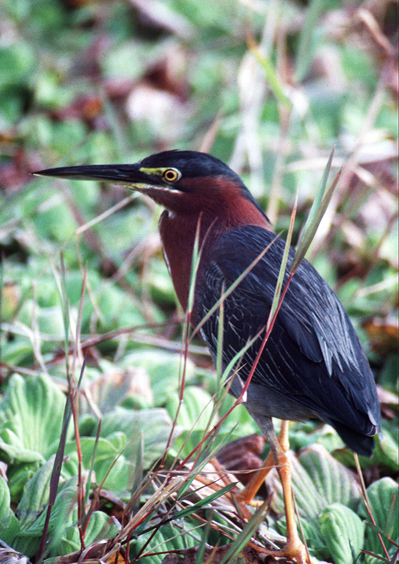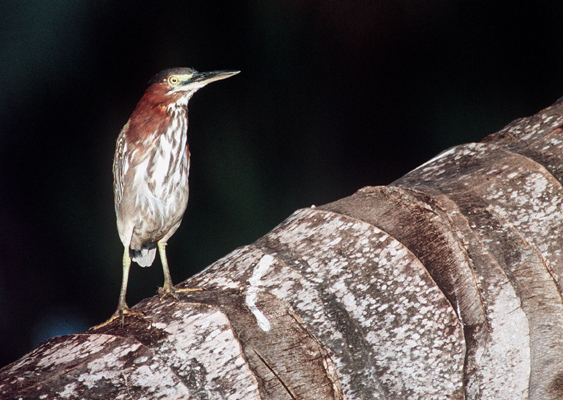|
Green Heron Butorides virescens Martinete,
|
 |
|
Photo: G. Beaton
|
|
IDENTIFICATION: A small, gray and green heron with a rufous neck. Immatures are duller and more streaked. Length: 41-46 cm.; weight: 240 g. VOICE: A loud "skeow" call, followed by rapid clucking when disturbed. Audio (M. Oberle). HABITAT: Fresh and salt water marshes, Pterocarpus forest, ponds, canals, mangroves, stream borders, calm ocean shores, wet fields, even gardens. HABITS: The Green Heron usually forages alone by crouching on a riverbank or low branch and waiting for prey. It has the distinction of being Puerto Rico’s only tool-using bird: it occasionally uses bait (twigs, leaves, worms, flies) to attract small fish within reach. It sometimes plunges into shallow water after prey, and will eat crabs, crayfish, insects, and other invertebrates, as well as fish, frogs, and lizards. Crickets, grasshoppers, beetles and dragonfly larvae were important prey in one study of Green Herons in Puerto Rico. Although often hidden in streamside vegetation, this species sometimes perches on wires, branches or fences, and is often seen flying at treetop level to or from roosts and feeding areas. The Green Heron often nests alone, but sometimes nests in treetop colonies with other heron species. The male collects twigs and passes them to the female for nest building. She lays 3-5 blue-green eggs. Both sexes share incubation duties for 19-21 days, and subsequently brood and feed the chicks for the first three weeks after hatching. Chicks can fly about 21-22 days after hatching and accompany their parents to feeding areas shortly thereafter. Birds nesting in eastern and central North America winter along the coast of the Gulf of Mexico and in the West Indies. One Green Heron banded in Maryland was recovered in Puerto Rico. STATUS AND CONSERVATION: Common, permanent resident of Puerto Rico, with migrant birds increasing the population in winter. This species has suffered from wetlands destruction, but has benefited from some forms of development, including drainage ditches, water impoundments, and golf-course water traps that have created new habitat. Overall its population in eastern North America---from which many winter migrants to Puerto Rico originate---has increased in recent years. RANGE: Breeds from southeastern Canada and British Columbia, south through the Greater Antilles and lowland Central America to Panamá and Tobago. A regular species in most wetlands throughout Puerto Rico. TAXONOMY: CICONIIFORMES; ARDEIDAE. This species has also been called the Little Green Heron and Green-backed Heron. |
|
 |
|
Photo: G. Beaton
|
 |
|
|
Photo: G. Beaton
|



